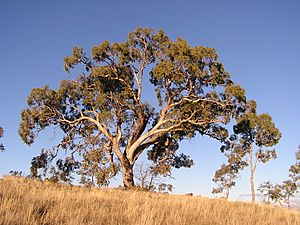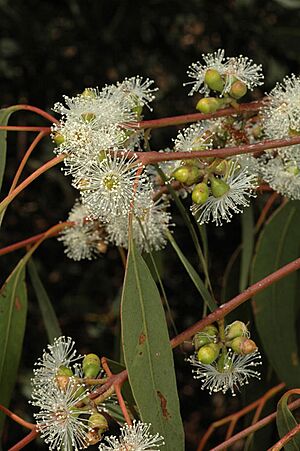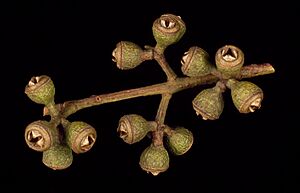Apple box facts for kids
Quick facts for kids Apple box |
|
|---|---|
 |
|
| Eucalyptus bridgesiana in the Australian Capital Territory | |
| Scientific classification | |
| Genus: |
Eucalyptus
|
| Species: |
bridgesiana
|
The apple box (scientific name: Eucalyptus bridgesiana) is a medium to large tree. It's also known as apple gum or but-but. This tree has rough, stringy bark on its main trunk and bigger branches. Its smaller branches have smooth, grey bark. The adult leaves are shiny green and shaped like a spear.
The apple box tree produces flower buds in groups of seven. These buds open into white flowers. After flowering, the tree grows fruit that looks like a small, woody cup.
Contents
About the Apple Box Tree
The apple box tree usually grows to be about 20 to 25 meters (65 to 82 feet) tall. It has a special woody swelling at its base called a lignotuber. This helps the tree regrow if it gets damaged, for example, by fire.
The bark on the trunk and large branches is rough and stringy. It's a mix of grey and white, sometimes looking like a puzzle. The bark on thinner branches is smooth and grey, with white patches. This smooth bark peels off in short strips.
Leaves of the Apple Box
Young apple box plants have leaves that are different from adult leaves. These young leaves are egg-shaped or heart-shaped. They are arranged in pairs opposite each other on the stem. They can be 2.5 to 10 centimeters (1 to 4 inches) long and 2 to 8 centimeters (0.8 to 3 inches) wide. Their edges are wavy, and they often have a powdery white coating.
Adult leaves are shiny green on both sides. They are shaped like a spear, measuring 12 to 20 centimeters (5 to 8 inches) long and 1.5 to 2.5 centimeters (0.6 to 1 inch) wide. Each adult leaf has a stem called a petiole that is 1.2 to 3.5 centimeters (0.5 to 1.4 inches) long.
Flowers and Fruit
The apple box tree's flower buds grow in groups of seven. Each group is on a stalk up to 1.5 centimeters (0.6 inches) long. The individual buds are on smaller stalks, 1 to 5 millimeters (0.04 to 0.2 inches) long.
When the buds are ready to open, they are oval-shaped. They are 5 to 8 millimeters (0.2 to 0.3 inches) long and 3 to 5 millimeters (0.1 to 0.2 inches) wide. Each bud has a cap, called an operculum, which can be cone-shaped or have a small beak.
Apple box trees usually flower from February to March. Their flowers are white. After the flowers, the tree produces woody fruit. This fruit is shaped like half a sphere and is 3 to 7 millimeters (0.1 to 0.3 inches) long and 4 to 8 millimeters (0.2 to 0.3 inches) wide. When the fruit opens, three parts stick out above the rim.
How it Got its Name
The scientific name Eucalyptus bridgesiana was first officially described in 1898. This was done by a scientist named Richard Thomas Baker. His description was published in a scientific journal called Proceedings of the Linnean Society of New South Wales.
The second part of the name, bridgesiana, was chosen to honor Frederick Bridges (1840-1904). He was recognized for helping to promote the useful qualities of Australia's native plants.
Where Apple Box Trees Grow
Apple box trees grow in open woodlands and forests. You can find them in many places. They are common from near Stanthorpe in Queensland. They also grow south through the slopes and ranges of New South Wales and eastern Victoria.
Uses of the Apple Box Tree
The wood from the apple box tree is softer than the wood from other eucalypt trees. Because of this, it's not considered very good for firewood or for building things.
However, the small white flowers of the apple box tree are very important for bees. Bees collect nectar from these flowers to make honey. The honey produced from apple box flowers is known to be of high quality.
Images for kids




